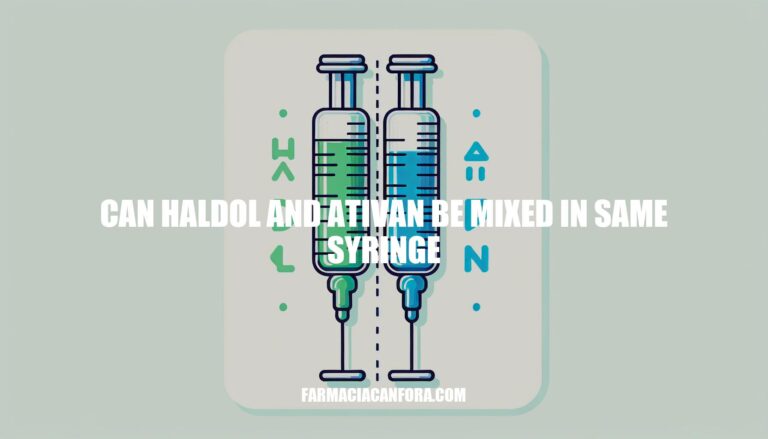Understanding whether Haldol (haloperidol) and Ativan (lorazepam) can be mixed in the same syringe is crucial in medical practice. This knowledge ensures safe and effective administration of medications, particularly in emergency and psychiatric settings where these drugs are often used together. Mixing incompatible medications can lead to adverse reactions, reduced efficacy, and potential harm to patients. Therefore, it’s essential for healthcare professionals to be well-informed about drug compatibility to provide the best care possible.
Compatibility of Haldol and Ativan
When mixed in the same syringe, Haldol (haloperidol) and Ativan (lorazepam) are generally considered chemically compatible. This combination is often used in emergency psychiatric settings to manage acute agitation or psychosis.
However, there are some important considerations:
- Precipitation: No significant precipitation occurs when these two drugs are mixed.
- Stability: The mixture remains stable and effective for administration.
- Interactions: Both drugs can potentiate each other’s sedative effects, which can lead to increased sedation and respiratory depression.
It’s always best to consult with a pharmacist or refer to your facility’s guidelines for the most accurate and safe practices.
Clinical Guidelines
Mixing Haldol (haloperidol) and Ativan (lorazepam) in the same syringe is generally considered acceptable in clinical practice, but it should be done with caution. Here are the key guidelines and recommendations:
- Compatibility: Haldol and Ativan are compatible for mixing in the same syringe.
- Procedure: Draw up Haldol first, then Ativan.
- Consultation: Always consult your facility’s syringe compatibility chart or a pharmacist if unsure.
- Aseptic Technique: Maintain aseptic technique to avoid contamination.
These guidelines ensure safe and effective administration of these medications.
Case Studies and Evidence
-
Case Study: Compatibility and Precipitation
- Observation: Haldol (haloperidol) and Ativan (lorazepam) are generally considered compatible for mixing in the same syringe. However, Benadryl (diphenhydramine) should not be mixed with Haldol due to precipitation forming within about 5 minutes.
-
Clinical Evidence: Agitated Delirium in End-of-Life Patients
- Outcome: A single dose of lorazepam combined with haloperidol was effective in decreasing agitation in end-of-life cancer patients with persistent agitated delirium.
-
Nursing Practice: Emergency Treatments
- Observation: Nurses have reported mixing Haldol and Ativan in the same syringe without issues, but always consult pharmacy or compatibility charts when in doubt.
-
General Nursing Support
- Observation: Ativan and Benadryl are compatible, but Haldol and Benadryl are not. Therefore, the B52 cocktail (Haldol, Ativan, Benadryl) requires at least two syringes.
Potential Risks and Benefits
Mixing Haldol (haloperidol) and Ativan (lorazepam) in the same syringe can have both potential risks and benefits:
Benefits:
- Convenience: Combining the medications can simplify administration, especially in emergency situations where rapid sedation is required.
- Efficacy: The combination can be effective in managing acute agitation and psychosis, providing both antipsychotic and anxiolytic effects.
Risks:
- Precipitation: Mixing these drugs can lead to precipitation, which may reduce the efficacy of the medications and cause irritation at the injection site.
- Cardiorespiratory Depression: There is an increased risk of cardiorespiratory depression when combining these medications, which can be dangerous for the patient.
- Incompatibility: The pH and chemical properties of the drugs may interact negatively, potentially altering their effectiveness.
Implications for Patient Safety and Treatment Efficacy:
- Patient Safety: The risk of severe side effects, such as respiratory depression, necessitates careful monitoring. Ensuring compatibility and avoiding precipitation is crucial to prevent adverse reactions.
- Treatment Efficacy: While the combination can be effective, the potential for reduced efficacy due to precipitation and chemical incompatibility must be considered. Proper administration techniques and consultation with pharmacy guidelines are essential to maximize treatment benefits and minimize risks.
Haldol (Haloperidol) and Ativan (Lorazepam): A Chemically Compatible Combination
Haldol (haloperidol) and Ativan (lorazepam) are generally considered chemically compatible when mixed in the same syringe, but there are some important considerations to ensure safe administration.
The combination is often used in emergency psychiatric settings to manage acute agitation or psychosis. However, mixing these drugs can lead to increased sedation and respiratory depression due to potentiation of each other’s effects.
It’s essential to consult with a pharmacist or refer to facility guidelines for the most accurate and safe practices. Aseptic technique should be maintained to avoid contamination.
Mixing Guidelines
- Draw up Haldol first, then Ativan.
- Consult facility charts or pharmacists if unsure.
- Maintain aseptic technique.
While there are potential risks and benefits to mixing these medications, the combination can be effective in managing acute agitation and psychosis, providing both antipsychotic and anxiolytic effects. However, careful monitoring is necessary due to the risk of severe side effects such as respiratory depression.
Conclusion
Haldol and Ativan can be safely mixed in the same syringe when proper administration techniques are followed and compatibility is ensured, but it’s crucial to weigh the potential benefits against the risks and take necessary precautions to prevent adverse reactions.


